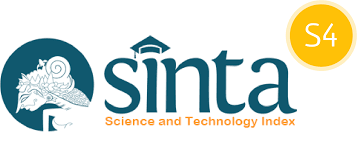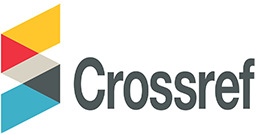Aspergillus sp. For Indigosol Blue and Remazol Brilliant Blue R Decolorization
Abstract
Synthetic dyes are artificial dyes manufactured by Industry and commonly used for the textile industry. These dyes had potentially caused an environmental problem. Many types of dyes are recalcitrant and have toxic properties for living organisms. It can be removed by decolorization method, especially a biological decolorization by fungi. Fungi were chosen due to the ability to degrade toxic components. Aspergillus sp. is the fungi which commonly used for dye decolorization. It might be caused that Aspergillus sp. is one type of fungi lived in the textile waste and expected not to die in the dye decolorization treatment. The purpose of this research was to investigate the ability of the mycelia pellets of Aspergillus sp to decolorized Indigosol Blue dye and Remazol Brilliant Blue R (RBBR) dye. This research showed that mycelial pellets of Aspergillus sp. had high activity of decolorization of Indigosol Blue dye up to 85.37% and RBBR dye up to 80.21% and caused low pH value after 24 hour incubation time compared to the control solution.
References
Ahmad, M. A., Yun, E. T. C., Abustan, I., Ahmad, N., & Sulaiman, S. K., 2011. Optimization of Preparation Conditions for Corn Cob Based Activated Carbons for the Removal of Remazol Brilliant Blue R dye. International Journal of Engineering & Technology, 11(1) : 216-221.
Aryanti, N., Sandria, F. K. I., Putriadi, R. H., & Wardhani, D. H., 2017. Evaluation of Micellar-Enhanced Ultrafiltration (MEUF) Membrane for Dye Removal of Synthetic Remazol Dye Wastewater. Engineering Journal, 21(3) : 23-35.
Awaluddin, R., Darah, S., Ibrahim, C. D. & Uyub, A. M., 2001. Decolorization of Commercially Available Synthetic Dyes by The White Rot Fungus Phanerochaete chrysosporium ME 446 (ATCC 34541). Kuala Lumpur, Proceedings of NSF Workshop.
Bassyouni, D. G., Hamad, H. A., El-Ashtoukhy, E-S. Z., Amin, N. K., and Abd-El Latif, M. M., 2017. Comparative performance of anodic oxidation and electrocoagulation as clean processes for electrocatalytic degradation of diazo dye Acid Brown 14 in aqueous medium. Journal of Hazardous Material, 335 : 178-187.
Dewi, R. S., & Lestari, S., 2010. Dekolorisasi Limbah Batik Tulis Menggunakan Jamur Indigenous Hasil Isolasi pada Konsentrasi Limbah yang Berbeda. Molekul, 5(2) : 75-82.
Dewi, R. S., Kasiamdari, R. S., Martani, E. & Purwestry, Y. A., 2018a. Bioremediation of Indiosol Blue-04B Batik effluent by Indienous Fungal Isolates, Aspergillus spp. Omni Akuatika, 14(2) : 11-20.
Dewi, R. S., Kasiamdari, R. S., Martani, E. & Purwestry, Y. A., 2018b. Decolorization and detoxification of batik dye effluent containing Indigosol Blue-04B using fungi isolated from contaminated dye effluent.Indonesian Journal of Biotechnology, 23(2) : 54-60.
Dewi, R. S., Kasiamdari, R. S., Martani, E. & Purwestry, Y. A., 2019. Optimization of The Conditions for The Decolorization of Batik Wastewater by Aspergillus sp. 3. AIP Conference Proceedings. Hlm. 1-9. [online] https://aip.scitation.org/doi/abs/10.1063/1.5097505 [Diakses 28 Agustus 2019].
Hadianto A. D., 2000. Pengaruh TA dan Penambahan H2O2 Terhadap Elektrodekolorisasi Pewarna Indigo [skripsi]. Universitas Diponegoro Semarang.
Hefnawy, M. A., Gharieb, M. M., Shaaban, M. T. & Soliman, A. M., 2017. Optimization of Culture Condition for Enhanced Decolorization of Direct blue Dye by Aspergillus flavus and Penicillium canescens. Journal of Applied Pharmaceutical Science, 7(2) : 83-92.
Herfiani, Z. H., Rezagama, A., & Nur, M. 2017. Pengolahan limbah cair zat warna jenis indigosol blue (C.i Vat Blue 4) sebagai hasil produksi kain batik menggunakan metode ozonasi dan aadsorpsi arang aktif batok kelapa terhadap parameter cod dan warna. Jurnal Teknik Lingkungan, 6 (3): 1-10.
Kunjadia, P. D., Sanghvi, G. V., Kunjadia, A. P., Mukhopadhyay, P. N., & Dave, G. S., 2016. Role of ligninolytic enzymes of white rot fungi (Pleurotus spp.) grown with azo dyes. Springerplus, 5 : 1487-1495.
Przystas, W., Zabłocka-Godlewska, E., & Grabinska-Sota, E., 2018. Efficiency of Decolorization of Different Dyes using Fungal Biomass Immobilized on Different Solid Supports. Brazilian Journal of Microbiology, 49(2) : 285-295.
Rahmat, N. A., Ali, A. A., Salmiati., Hussain, N., Muhammad, M. S., Kristanti, R. A., & Hadibarata, T., 2016.
Removal of Remazol Brilliant Blue R from Aqueous Solution by Adsorption Using Pineapple Keaf Powder and Lime Peel Powder. Water, Air, and Soil Pollution, 227(195) :. 1-11.
Singh, A., Ghosh, A., & Dastidar, M. G., 2018. Decolorization of Reactive Yellow 17 Dye Using Aspergillus tamarii. Environmental Pollution, 77 : 309-316.
Steingruber, E. 2004. Indigo and Indigo Colorants. Ullmann's Encyclopedia of Industrial Chemistry, Wiley-VCH, Weinheim.
Torgut, G., Tanyol, M., Biryan, F., Pihtili, G., & Demirelli, K., 2017. Application of response surface methodology for optimization of Remazol Brilliant Blue R removal onto a novel polymeric adsorbent. Journal of Taiwan Institute of Chemical Engineers, 80 : 406-414.
Yucel, T. T., 2018. Investigation of Some Parameters Affecting Methyl Orange Removal by Fusarium acuminatum. Brazilian Archives of Biology and Technology, 61 : 1-9.
Zhang, F. & Yu, J., 2000. Decolorization of Acid Violet 7 With Complex Pellets of White Rot Fungus and ActivatedCarbon. Bioprocess Engineering, 23(3) : 295-301













